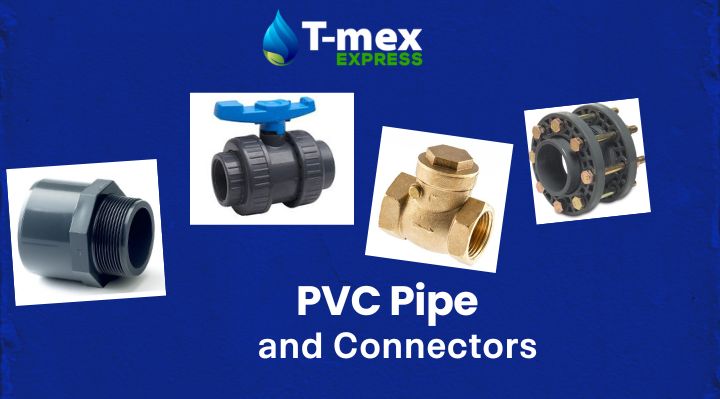PVC plumbing connections are a big part of what makes our water flow smoothly at home, in schools, and just about anywhere. These lightweight and versatile connectors are used for everything from bringing water to our taps to carrying it away. If you’re curious about how PVC pipe and connectors work, this guide breaks it down into simple steps.
What is PVC, and Why is it So Popular?
PVC stands for polyvinyl chloride, a type of plastic that’s super tough but also easy to work with. It’s a favourite in plumbing because it’s lightweight, doesn’t rust, and is durable. PVC pipes can handle both cold and hot water, making them perfect for many uses. PVC pipes are used in 66% of water distribution systems across Europe!
Another reason people love PVC is its affordability. It’s much cheaper than metal pipes, and its smooth surface means water flows through it easily, reducing the chances of clogs.
How Do PVC Plumbing Connections Work?
PVC plumbing connections involve joining pipes and fittings together to create a seamless system for water flow. These connectors come in various shapes, sizes, and designs. Here are the main types:
1. Couplings: These straight connectors join two pipes together.
2. Elbows: These let pipes turn at 90° or 45° angles.
3. Tees: Shaped like a "T," these connectors allow you to split the water flow into two directions.
4. Adapters: These help connect PVC pipes to pipes made of other materials, like copper or steel. The pipes and connectors are glued together with a special solvent cement that softens the plastic, creating a bond stronger than the pipe itself.
Key Benefits of PVC Plumbing Connections
PVC plumbing connections are trusted worldwide for a reason. Here are a few highlights:
• Durability: PVC pipes can last up to 100 years in some cases.
• Environmentally Friendly: PVC is recyclable and produces fewer greenhouse gases during its production compared to other materials.
• Corrosion-Free: Unlike metal, PVC doesn’t rust or corrode, even when exposed to harsh chemicals.
Technical Tidbits
Want to know more? Let’s dive into a few quick stats and facts:
• PVC pipes can handle pressures of up to 200 pounds per square inch (psi), depending on their size and thickness.
• They’re capable of transporting water at temperatures up to 60°C (140°F).
• The most common sizes for residential use are 20mm to 50mm in diameter, but they can go much larger for industrial purposes.
Where are PVC Pipe and Connectors Used?
PVC plumbing connections aren’t just for your kitchen sink or bathroom shower. They have plenty of other uses:
• Irrigation Systems: Farmers use PVC pipes to water their crops efficiently.
• Drainage: Rainwater drains and sewage systems often rely on PVC for smooth, long-lasting performance.
• Aquariums: Many fish tanks and marine setups use PVC for their filtration systems.
Tips for Installing PVC Plumbing Connections
If you’re thinking about tackling a PVC plumbing project yourself, here are some handy tips to keep in mind:
1. Measure Twice, Cut Once: Use a tape measure to ensure your pipes are cut to the exact size you need.
2. Smooth the Edges: After cutting the pipe, sand the edges to remove rough spots that could cause leaks.
3. Prime and Glue: Apply a PVC primer before the glue for the strongest bond. Don’t skip this step!
4. Test for Leaks: After assembling everything, run water through the system to ensure there are no leaks.
Fun Fact: PVC in the UK
Did you know that the UK uses over 250,000 tonnes of PVC pipes annually? That’s enough pipe to wrap around the Earth several times! PVC is a favourite material for everything from residential plumbing to massive infrastructure projects.
Why PVC is Here to Stay
PVC plumbing connections aren’t going anywhere. They’ve been around for decades and continue to evolve with better designs and materials. Whether you’re building a new home, upgrading an old system, or working on a DIY project, PVC is a reliable and affordable choice.
With its unbeatable combination of strength, flexibility, and cost-effectiveness, PVC is the backbone of modern plumbing. And now that you know how it works, you’re ready to tackle your next plumbing challenge like a pro!
Dive into your PVC project today and see the difference for yourself!
PVC plumbing connections are more than just pipes and connectors; they’re the unsung heroes that keep our water flowing smoothly. From their eco-friendly benefits to their long lifespan and versatility, PVC is an essential part of daily life. So, whether you’re fixing a leak or starting a big plumbing project, PVC pipe and connectors are the way to go. They’re easy to use, budget-friendly, and built to last.
